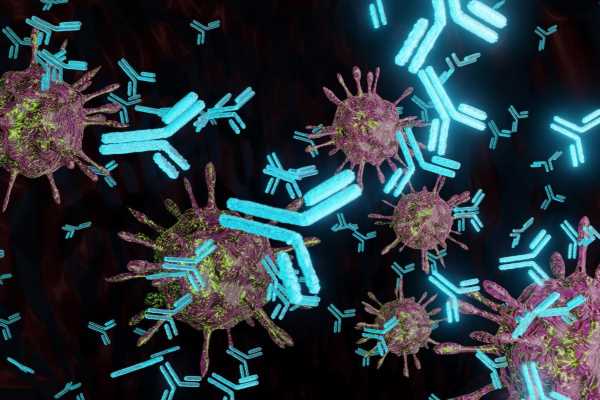In a recent study posted to the bioRxiv* preprint server, researchers demonstrated the potent neutralization of severe acute respiratory syndrome coronavirus 2 (SARS-CoV-2) variants of concern (VOCs), including Omicron by the biparatopic human heavy chain variable domain (VH), F6. Further, the team developed an antibody construct against the SARS-CoV-2 VOCs via incorporating the VHF6 to VHab8.

Following the emergence of SARS-CoV-2 in late 2019, there have been 426 million SARS-CoV-2 infections and 5.89 million deaths associated with coronavirus disease 2019 (COVID-19) worldwide. The subsequently emerged SARS-CoV-2 VOCs, including Delta, Beta, Gamma, Alpha, and the recently identified Omicron, exhibited an enhanced capacity to evade the immune protection induced by vaccination or natural infection.
Recent investigations have shown that the multi-specific antibody (Ab) cocktails or Abs provide significant resistance to mutational escape of the SARS-CoV-2 VOCs via targeting numerous epitopes on the SARS-CoV-2 spike (S) protein. Additionally, various bispecific Abs have been demonstrated to be broadly neutralizing against the SARS-CoV-2 VOCs. These findings demonstrate the significance of multi- or bi-specific neutralizing Abs (nAbs) effective against a wide range of SARS-CoV-2 strains to curtail the COVID-19 pandemic.
About the study
In the present study, the scientists analyzed a human VH domain, F6, that they created by panning large phage-displayed VH libraries against SARS-CoV-2 receptor binding domains (RBDs) with VOC mutations in a sequential manner.
The researchers conducted a sequential panning approach employing the SARS-CoV-2 E484K mutated RBD, wild type (WT) RBD, and the S protein S1 domain-comprising K417N, E484K, and N501Y mutations for the first, second, and third rounds of panning, respectively. Following the sequential panning, through enzyme-linked immunosorbent assay (ELISA), the team determined a dominant VH clone against SARS-CoV-2 VOCs. Further, the researchers characterized the cross-reactivity of the dominant VH clone by pseudovirus neutralization assays and ELISA.
By solving a cryoelectron microscopy (cryoEM) structure of VHF6 bound with a prefusion stabilized SARS-CoV-2 Beta S trimer at a global resolution of 2.8 Å, the researchers garnered structural information regarding the extensive neutralizing ability of the VHF6 domain.
Lastly, the therapeutic and prophylactic potential of the anti-SARS-CoV-2 Ab candidate developed in the study, F6-ab8-Fc, was estimated in vivo employing a mouse-adapted SARS-CoV-2 infection model using the SARS-CoV-2 Beta variant.
Results
The results demonstrate that the VHF6 broadly neutralized the SARS-CoV-2 Omicron, Delta, Gamma, Beta, and Alpha variants.
The Cryo-EM analyses indicated VHF6 targeted a class-four epitope that spans the SARS-CoV-2 RBD peak and valley outer-faces and partly overlaps with the human angiotensin-converting enzyme 2 (hACE2) binding interfaces. Hence, this suggests that the VHF6 binds with a comparatively conserved portion of the SARS-CoV-2 receptor binding motif (RBM) via a distinctive framework region (FR)-driven paratope.
Additionally, the cryoEM structure of VHF6 with the SARS-CoV-2 Beta S protein demonstrated that the SARS-CoV-2 VOCs mutations were either outside of the VHF6 epitope or within its circumference. The VHF6 epitope was comparable to the full-length Ab, A19-46.1, and both neutralized the SARS-CoV-2 Omicron variant. VHF6 was resistant to the SARS-CoV-2 L452R mutation, unlike the A19-46.1, and exhibited binding with the RBD in up and down conformations.
Moreover, VHF6 demonstrated a distinct binding mechanism to the SARS-CoV-2 RBD, presenting a hydrophobic contact surface via its exposed FR regions and complementarity determining region (CDR3). This interaction pattern was similar to llama/shark VH Abs, which fold against the FR2 region using long CDR3s and form unique paratopes collectively.
The linking of a fragment crystallizable (Fc) region to a VH domain previously identified by the researchers, VHab8, resulted in an F6-ab8-Fc construct that neutralized Omicron pseudoviruses in vitro with a half-maximal inhibitory concentration (IC50) of 4.8 nM. Additionally, the biparatopic Ab, F6-ab8-Fc exhibited potential neutralizing capacity against various SARS-CoV-2 live virus variants and all VOCs pseudoviruses. Furthermore, prophylactic therapy with F6-ab8-Fc lowered the viral titers of the live Beta variant in the lungs of a mouse model, and higher doses protected against COVID-19-related death in them.
Conclusions
The study demonstrated a broadly neutralizing SARS-CoV-2 antibody domain, VHF6, with a distinct epitope and paratope that neutralized all SARS-CoV-2 VOCs. Thus, the VHF6 epitope might be used to generate substantially neutralizing vaccines and Abs against SARS-CoV-2 variants that are currently circulating. Further, the F6-ab8-Fc, the biparatopic Ab, because of its in vivo and extensive neutralization activities, furnishes a novel SAR-CoV-2 Ab candidate against the present SARS-CoV-2 VOCs.
The study establishes a novel potential therapeutic candidate, F6-ab8-Fc, against the SARS-CoV-2 VOCs, including the currently dominant heavily mutated Omicron variant. Furthermore, it underscores a susceptible epitope within the SARS-CoV-2 S RBD, which can be used to develop extensive protection against the circulating SARS-CoV-2 variants.
*Important notice
bioRxiv publishes preliminary scientific reports that are not peer-reviewed and, therefore, should not be regarded as conclusive, guide clinical practice/health-related behavior, or treated as established information.
-
Chen, C. et al. (2022) "Potent Neutralization of Omicron and other SARS-CoV-2 Variants of Concern by Biparatopic Human VH Domains". doi: 10.1101/2022.02.18.481058. https://www.biorxiv.org/content/10.1101/2022.02.18.481058v1
Posted in: Medical Science News | Medical Research News | Disease/Infection News
Tags: Angiotensin, Angiotensin-Converting Enzyme 2, Antibody, Assay, Coronavirus, Coronavirus Disease COVID-19, covid-19, Enzyme, in vitro, in vivo, Lungs, Microscopy, Mouse Model, Mutation, Omicron, Pandemic, Protein, Pseudovirus, Receptor, Respiratory, SARS, SARS-CoV-2, Severe Acute Respiratory, Severe Acute Respiratory Syndrome, Syndrome, Virus

Written by
Shanet Susan Alex
Shanet Susan Alex, a medical writer, based in Kerala, India, is a Doctor of Pharmacy graduate from Kerala University of Health Sciences. Her academic background is in clinical pharmacy and research, and she is passionate about medical writing. Shanet has published papers in the International Journal of Medical Science and Current Research (IJMSCR), the International Journal of Pharmacy (IJP), and the International Journal of Medical Science and Applied Research (IJMSAR). Apart from work, she enjoys listening to music and watching movies.
Source: Read Full Article
